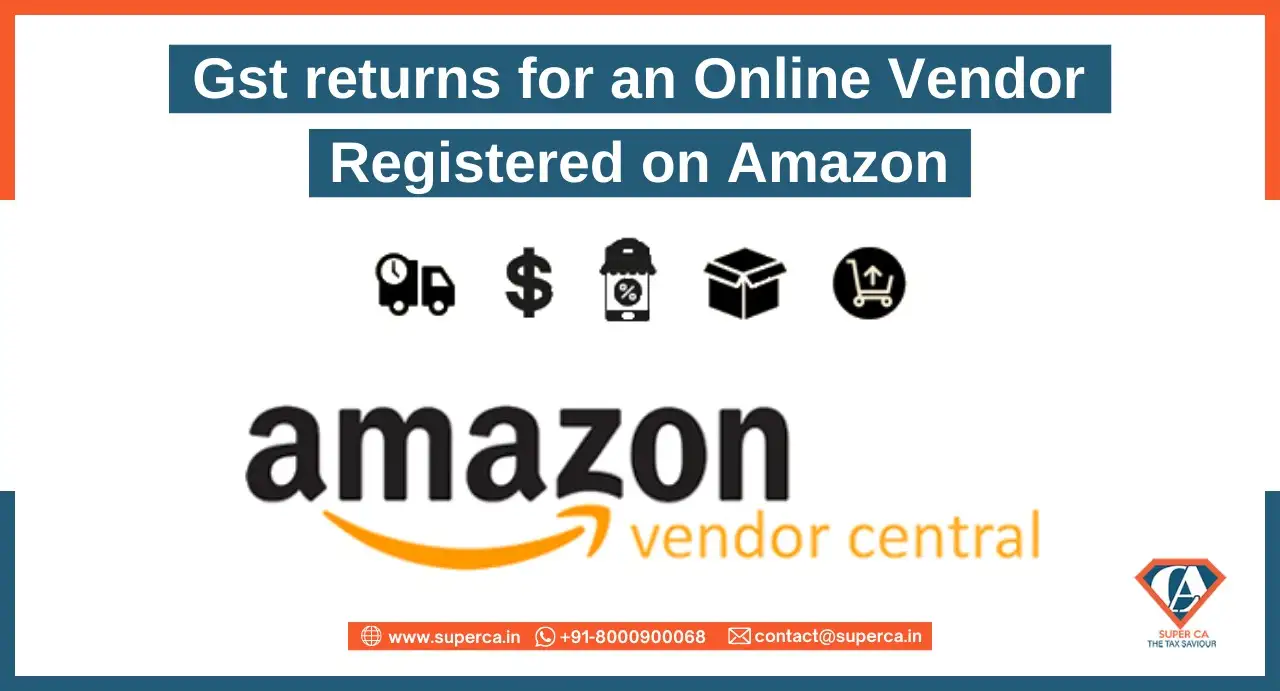GST returns for an online vendor registered on Amazon
- Posted By SuperCA
- On 19 September

About
India has seen a boom in expansion and penetration of various E-commerce platforms like amazon, flipkart, snapdeal with great momentum in the past few years. These platforms allow other traders to become a seller on these platforms.
GST was introduced by the government as a single tax for the entire country in order to simplify the Indirect Tax System. GST registration serves as the foundation for all tax lines, including Central Excise, Service Tax, and VAT etc. Now, any Seller or Vendor is required to get registered under GST to be able to sell on these platforms. Here is a complete guide on how to file returns if you want to sell goods on any of these platforms.
The rules are different for people who provide services via platforms like urbanclap or provide food via swiggy or cab service via uber/ola. This guide is only for persons who sell goods on amazon, flipkart or other similar platforms.
Why is GST Registration and filing mandatory for Amazon Vendors/Sellers
Everyone has to pay taxes on all products and services, the most basic of which is the GST filing. It is the process of collecting taxes on behalf of the government. With the coming of GST, one of the major change is coming for online sellers and marketplaces and the same is that e-commerce platforms like Flipkart, Amazon, etc are mandatorily required to deduct 1% TCS (Tax Collected at Source) while making payments to their suppliers and the same gets deposited by these platforms as GST liability of seller with the Government.
This TCS which is collected by the E-commerce platform can be claimed as credit by the online seller by filing the monthly returns under GST. Therefore, GST registration and filing are mandatory.
GST Returns Filing for Amazon Sellers
So far we know why registration under GST is important if you are a seller or are planning to be a seller on Amazon (exception: if deals only with GST-exempt categories). Now, your question would be what are the various GST filing forms which are required to be filed by you? Well, below are the details of various forms to be filed. Proper and timely filing of the forms allows you to conduct business online while fulfilling tax compliances.
GSTR-1 (Statement of Outward Supplies made)
It is the monthly details of outward supplies and is filed by the 10th of next month. This form contains -
➔ Basic information like Business Name along with GSTIN, period for which the return is being filed, etc.
➔ Details of invoices issued in the previous month and the corresponding taxes to be paid.
➔ Details of advances received against a supply to be made in future.
➔ Details of revision in relation to outward sales invoices pertaining to previous tax periods.
GSTR-2 (Statement of Inward supplies made) (Currently suspended)
It contains the return of inward supplies of goods and services made and was filed on the monthly basis by the 15th of every month.
GSTR 3 (Summarizing the details of inward and outward supplies.)(Currently suspended)
It is currently a suspended auto populated document based on the details filled in GSTR-1, GSTR-2 and tax liability of any preceding period. Filing of this return has been suspended since September 2017.
GSTR-3B (Inward and Outward supply summary)
To address the concerns raised by the various trade and industrial bodies, and to ensure the smooth roll out of GST, the GST Council decided to extend the timeline for invoice-wise return filing in Form GSTR-1 and Form GSTR-2 for a period of six months, i.e. up to December, 2017. Now businesses need to file a simple return in Form GSTR-3B by declaring the summary of inward supplies and outward supplies.
Details of ITC and sales details must be reconciled with GSTR-1 and GSTR-2B every tax period before filing GSTR-3B.
The due date is as follows -
Monthly - 20th of the every month from January 2021 onwards (For taxpayers having an aggregate turnover of more than Rs.5 crore in previous FY)
Quarterly - 22nd or 24th of the month next to the quarter (For taxpayers opted into the QRMP scheme.)
FORM GSTR-4 (Quarterly return for composition traders.)
It is the quarterly return filed by the 18th of the month after the end of a quarter.
A small taxpayer (i.e. a taxpayer with a turnover of up to Rs. 1 Crore) has the option to opt for the composition scheme. In such a case, he would be required to pay taxes at a fixed rate depending on the type of his business (2% for manufacturers, 5% for the restaurant service sector and 1% for other suppliers). Although no input tax credit facility would be available under the composite scheme. A taxpayer opting for the composition scheme would be required to file a simplified quarterly return in Form GSTR-4. GSTR-4 includes the following details:
➔ The total value of consolidated supply made during the period of return, i.e. during the quarter.
➔ Details of payment of tax.
➔ Declare invoice-level purchase information.
Annual GST Return
The annual return in Form GSTR-9 (Annual GST return) is to be filed by 31st December of next financial year. Basically It is a merger of all the monthly or quarterly returns (GSTR-1, GSTR-2A, GSTR-3B) filed during that financial year.
This is intended to provide complete visibility about the activities of the taxpayer. However, from FY 2019-20 onwards, GSTR 9A Annual return has been replaced by GSTR 4.
Conclusion
Amazon provides a common platform for both sellers and buyers which helps sellers deliver products and services worldwide and buyers to search for the same from anywhere. In fact, it is one of the leading online retailers worldwide.
Therefore, it has wide scope for every business planning to take their business online. However, it is important to know the stepwise procedure to become a seller partner on amazon after getting GST Registration.
As most of the online sellers are unaware of these e-commerce platform rules under GST, they must strategically plan their transition into GST or getting a new registration and keep them aware of all the changes required to be done for a smooth flow of all operations.





